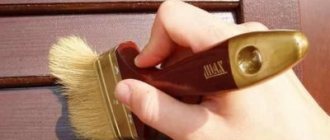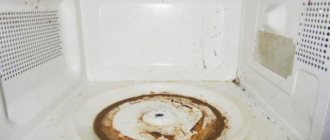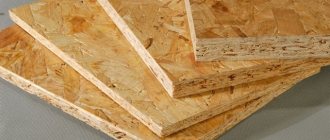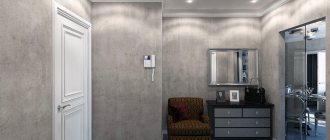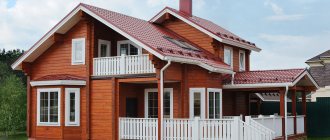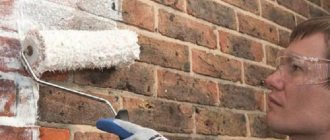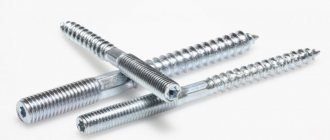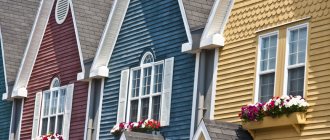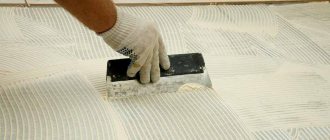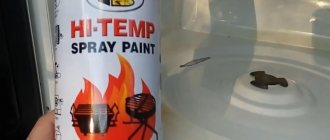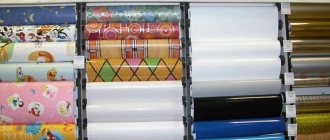Paint for OSB indoors. How to paint an OSB board inside a house
Today's:
- Concrete floor putty. Concrete floor putty
- The size of the bathroom in Khrushchev. The size of a standard bath in an apartment: in Khrushchev, in a panel house
- Grounding a private house in the basement. Are you here
- Disinfection of a polycarbonate greenhouse in the fall. What to process
- What does exhaust circulation in a hood mean? Ventilation or circulation?
- Plinth between the countertop and the apron. Do you need a plinth between the countertop and the “apron”?
- What glue to use to glue decorative stone to the wall. What glue is used for decorative stone for interior decoration?
- Paint for OSB indoors. How to paint an OSB board inside a house
- How to paint an OSB ceiling. Painting and priming of OSB ceilings and walls
- Preparing the OSB surface for painting
- The best paint for OSB boards. OSB paint: area of application
- External OSB paint. Features of OSB boards
- How to protect OSB on the street. Features of coloring particle-oriented panels
- Review of paint and varnish products
Why and how to paint the facade
Lightweight OSB boards are formed from chips and wood shavings by pressing and gluing. This is an environmentally friendly material, warm, breathable, but susceptible to atmospheric agents.
This is due to its design: two outer layers consist of longitudinally directed chips, and the third, inner one, of transversely directed chips. Layers of wood chips are impregnated with glue, but are still susceptible to moisture, fungus, and other negative influences, and it also looks unattractive. The owners prefer to paint the outside of the slab:
- for protection from moisture and destruction;
- as an antibacterial treatment;
- to give the facade an attractive appearance.
If necessary, we will paint it, we will try to turn our house into a cozy, beautiful little house.
Let's try the slab to the touch - it is uneven, rough, on both sides. Is it good or bad:
On the one hand, painting will not be easy - the paint only applies smoothly to a surface that is perfectly free of dust, burrs, puttied, and primed. And what we have are continuous tubercles and pits.
On the other hand, everything even and smooth is boring. And we can create something unique. So it turns out that painting OSB (as OSB board is also called) is a troublesome, but interesting task. Then we will choose what to paint OSB on the outside of the house.
Dyeing technology
OSB panels are painted only after they are fixed to the wall. Before painting, it is necessary to prepare the surface, level it and cover all joints with putty. After this, the material is ground, eliminating chips on the surface.
Preparation of OSB boards
Alignment of joints and marks from self-tapping screws is carried out with oil-adhesive putty for wood. Sometimes it is recommended not to try to hide the joints with putty, but after painting to decorate them with moldings made of plastic or metal. After drying the putty layer, do the following:
- Using a sanding machine, remove the top layer of wood with wax and varnish. This is a mandatory step when processing with stains. Sanding is also necessary to obtain smooth painted surfaces. If you want to preserve the texture, sanding the slab is not necessary.
- Before painting, the surfaces are primed with special compounds or diluted acrylic varnish (ratio with water 1:10). Alkyd varnish diluted with white spirit is also suitable for priming. For light paint, it is best to use an Aqua-filler type primer. Dry the applied layer of primer according to the instructions; if necessary, the treatment can be repeated. When the wall is completely dry, proceed to painting it.
Painting OSB boards indoors
- The paint is first applied with a medium brush to the edges of the slab, trying to paint the edge well if putty has not been applied.
- After this, use a wide brush or roller to paint the surface, performing all movements in one direction.
- Leave the wall to dry according to the instructions for the composition (for acrylic paints it will take only 8 hours).
- After drying, apply a second coat of paint.
Decorative painting of OSB boards in the interior
To decorate a wall in an industrial or loft style, an option coated with transparent varnish is suitable. The wall does not need to be shaded with stain.
A floor or wall hand-painted in different colors will look unusual. After applying 1-2 layers of base paint, small portions of dye are diluted over the entire surface and the colored details of the design are painted over with a thin brush, using the contours of the chips.
When finishing, you can also use standard techniques for working with decorative plaster:
- Paint the first layer 1-2 shades darker.
- Using a lint-free roller, apply a light shade to the protruding parts of the pattern.
- Apply varnish or continue finishing with glaze or mother-of-pearl.
Video description
Watch the video - 3 ways to decorate OSB:
The procedure is as follows:
- grinding to smooth out irregularities (P180 wheel), light pressure, maximum three passes;
- primer with a barrier composition to protect panel components, spray application, the layer dries completely on average within 2 hours, consumption per 1 m2 is no more than 60 g of material;
- painting with pigment primer, dries in 3 hours, consumption maximum 100 g;
- grinding with a circle, the pigment is removed, the surface becomes matte and smooth;
- application of acrylic varnish up to 120 g, the panel is covered in several layers, dries for about an hour;
- applying patina with a sprayer/airbrush per 1 m2 up to 80 g, avoid gaps, drying in 5-10 minutes;
- polishing the patina with a sponge (P320), a clear wood pattern is obtained;
- tinting with the selected color using acrylic varnish per 1 m2 maximum 120 g, the surface dries for several hours.
The varnish will change due to dullness. You can also choose compounds that provide a glossy surface.
Color option Source belydom.ru
Features of the technology - how to paint OSB boards indoors
When choosing paint, it is important to familiarize yourself with its composition, purpose and application technique. The following tips will reflect the features of using various painting materials for OSB:
- The oil composition is characterized by a long drying process. Therefore, repair work may be significantly delayed;
- Alkyd enamel is easily absorbed into the base, so it will take a lot of material to cover the surface;
- Water-dispersive agents cause partial deformations in the OSB structure. They are not suitable for covering non-moisture resistant classes of material;
- The varnish prolongs the service life and does not hide the texture;
- Use only impregnations intended for wooden materials.
Caring for painted OSB
If high quality paint has been chosen and the application is carried out in several layers in accordance with the painting technology, the surfaces will be easy to clean and will not lose their attractive appearance over time. For preventive purposes, you can renew the coating every 4–5 years with a fresh layer of varnish or paint diluted to translucency.
Due to the settlement of the building, it is possible for the slabs to peel off over time; in this case, it is better to completely tear off the planks and fasten them again, hiding the traces of the old fastenings with putty. You can repaint OSB almost an unlimited number of times, the main thing is not to apply an excessively thick layer and pre-treat the surface mechanically, improving adhesion.
general information
Material Details
Oriented Strand Board (OSB) is a composite material made from wood chips glued together using various resins, adhesives, polymers, etc. As a rule, OSB is made from aspen waste, but panels made from other materials are also found.
To protect the composite from moisture, it can be impregnated with a water-repellent composition or painted.
Depending on the characteristics of the chemical composition (impregnations, fillers, protective coatings, etc.), these products are classified into:
- OSB-1 - used for interior decoration of rooms with minimal humidity. They practically do not contain moisture-protective components.
- OSB-2 - used in rooms with normal humidity.
- OSB-3 - used for finishing walls and ceilings where there is a risk of getting wet or where there is increased background humidity.
- OSB-4 is the most durable and moisture-resistant variety. Such slabs should be purchased for the construction of load-bearing structures.
As a rule, panels of the second and third categories are used in finishing work. These are the ones we will focus on in our painting recommendations.
Benefits of painting
Finishing oriented strand materials using paints and varnishes has a number of advantages:
- Firstly, a layer of paint on the surface acts as an additional protection against moisture . Water does not penetrate into the thickness of the slab, which means the surface is not deformed.
- Secondly, the use of modern paints makes it possible to disguise the texture of OSB , formed from fairly large chips.
- Thirdly, this technique is less labor-intensive and expensive than cladding with decorative panels.
Note! OSB painting is more often used for interior decoration. The thing is that the slab experiences significant climatic influences from the outside, and therefore the base requires more serious protection.
Protective painting technologies are used both in everyday life and in industry.
As a rule, after painting, the treated slab is covered with a layer of varnish. This will protect the pigments from fading, and the base itself from damage.
Coloring and its advantages
Painting OSB has the following advantages:
- paint protects the material from moisture;
- hides the OSB texture;
- prevents cracking and deformation of products;
- It is simple and inexpensive.
The layer of applied paint does not allow moisture to penetrate into the thickness of the finished material. Without moisture, the slab does not warp. The chips used to make the slab are quite large. You can hide them with dyes. This is much cheaper and easier to do than using decorative panels. But the painting method can only be used indoors. After painting the OSB surfaces, they are varnished. The varnish protects the paint from fading.
For quality work, you need to choose good paints and varnishes. The best of them consist of organosoluble pigments. Such compositions are able to penetrate inside the panel. Oil paint is considered the best option. It creates a reliable protective layer on the surface. But you can use oil compositions only when there is no need to rush, since it takes quite a long time to dry. An alternative option is alkyd enamel. It penetrates deeply into the slab and creates a strong and durable coating. This coating does not need to be varnished.
You can treat the slabs with Valtti Color Satin impregnations produced by Tikkurila, if there is no need to hide the texture. These products can create a matte or semi-gloss film on the surface.
There are fire-retardant paints Polistil, Ognelat and some others. They cannot be used to protect OSB panels, since they are intended for metal. The best protection against fire are antipyretics Vuprotek, SPAS and others intended for wood.
The quality of painting work largely depends on the preparation of surfaces for finishing. For preparation and painting itself, it is necessary to use special tools and materials:
- brushes;
- rollers;
- putty knife;
- spray gun;
- compositions for painting;
- putty;
- sealant;
- sandpaper.
If possible, painting is done before installing the slabs. Their surface needs to be sanded, especially OSB-3. All irregularities and places where screws are screwed in are smoothed out using putty based on oil and glue. The seams between the plates are hidden with the same putty or sealant. But experienced craftsmen advise hiding them with decorative strips. Then the slab is primed with Aqua-Filler varnish. Other varnishes can be used. After this, all surfaces can be painted.
The paint is applied with a brush along the perimeter of the surface. Then take the roller in your hands and apply a full layer of dye. After 8 hours you can apply the next coat of paint. The strokes of this layer are applied across the previously applied ones.
Using the described scheme, you can give OSB products an original appearance. Various wallpapers and other means are suitable for finishing.
Preparing OSB boards for painting
The better you prepare OSB sheets for painting, the better the paint will adhere and the more durable the coating will be. It is not recommended to paint OSB panels before installation, because you will still have to adjust the joints and sand down any irregularities. It is better to paint an already prepared wall.
Next, we will consider the recommended procedure for preparing the surface of an OSB board for painting.
Step 1 - Sanding
Surface grinding is necessary only to smooth and hide the texture of the OSB board, as well as in the case of covering the surface with stains. This is best done with a sanding machine. To make the surface uniform, it will have to be carefully sanded. Boards of OSB-3 and OSB-4 grades will have to be subjected to especially deep grinding, since it is necessary to completely remove the protective coating of varnish and wax.
Preparation and application of paint
When painting OSB, it is better to apply paints and varnishes in two layers. The first is diluted with the addition of 10–15% of the appropriate solvent. This can be water, acetone or petroleum solvents, depending on the composition of the paint. The second layer is applied with solid paint.
Water-dispersed acrylic and latex paints have good spreadability and therefore, even when applied with a brush, no streaks or stains remain on them. It is advisable to apply more viscous polyurethane and alkyd coatings with a roller. As is typical for OSB, painting them with a spray bottle helps reduce consumption, which is very important for expensive patina or high-quality stains used in interior decoration.
There is a significant difference in whether the slabs are painted before or after they are fixed. In the latter case, it is necessary to paint the underside as well, otherwise uneven moisture will inevitably warp the slab. On the other hand, painting already installed slabs is characterized by lower consumption, but such cladding is inferior in moisture resistance, especially considering the lack of protection at the ends.
When painting OSB, it is very important to adhere to the strategy of applying many thin layers, no matter how great the temptation to smooth out the rough edges with a thick layer of thick paint. In the latter case, uneven absorption and, as a result, paint peeling is possible, especially when working with class 3 and 4 boards.
What paint should I use to paint the OSB board on the façade of the building?
To cover OSB panels outdoors, you need special paints. The composition intended for interior work is not used here. The level of its environmental friendliness is much higher, and therefore the price is corresponding, so it is not economically profitable to use such material for exterior finishing. The technical side of the issue also plays a role:
- Facade paint must have a high level of vapor permeability.
- The coating must prevent moisture from entering the surface of the panels.
- The best choice for panels with low moisture resistance would be latex and silicone based paints.
In reality, painting the slab and photos of the preparatory processes demonstrate that the outer OSB3 cladding is first coated with a primer. For these purposes, GF-020 and GF-021 soils have proven themselves to be excellent. Before painting the OSB board on the facade with a primer, it is first sanded and cleaned of dust.
For moisture-resistant sheets, alkyd enamels are suitable, which have repeatedly demonstrated examples of durable coatings. When implementing design projects, the surface is covered with stain, but the question may arise as to what varnish to cover the texture with. The answer is simple - vinyl or polyurethane; the decorative benefits of such treatment are very noticeable.
Maintaining the appearance and structure
Many people like the unusual texture of OSB boards, and they do not want to cover the natural pattern of wood chips. Whereas they paint OSB boards, which have an unusual appearance, in order to both preserve the beauty of the wooden structure and protect the house from bad weather.
On video: methods of decorative coating of OSB panels.
When deciding how to cover an uneven surface, consider clear paint with a UV filter. This varnish is created on the basis of alkyd resins; its components reliably protect the slab from external aggressive influences. The varnish gives a matte tint to the chipboard and preserves the pattern and structure.
Transparent varnish can be:
- water based;
- oil based;
- on acrylic base.
A matte or semi-matte acrylic varnish for exterior use will give a beautiful look to a painted slab. It is convenient to apply, and to obtain a better effect, you can treat the surface of the OSB board with water-based impregnation.
